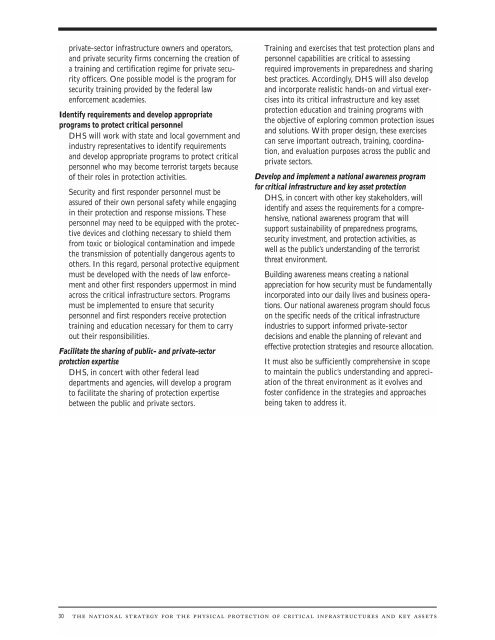the Physical Protection of Critical Infrastructures and Key Assets
the Physical Protection of Critical Infrastructures and Key Assets
the Physical Protection of Critical Infrastructures and Key Assets
Create successful ePaper yourself
Turn your PDF publications into a flip-book with our unique Google optimized e-Paper software.
private-sector infrastructure owners <strong>and</strong> operators,<br />
<strong>and</strong> private security firms concerning <strong>the</strong> creation <strong>of</strong><br />
a training <strong>and</strong> certification regime for private security<br />
<strong>of</strong>ficers. One possible model is <strong>the</strong> program for<br />
security training provided by <strong>the</strong> federal law<br />
enforcement academies.<br />
Identify requirements <strong>and</strong> develop appropriate<br />
programs to protect critical personnel<br />
DHS will work with state <strong>and</strong> local government <strong>and</strong><br />
industry representatives to identify requirements<br />
<strong>and</strong> develop appropriate programs to protect critical<br />
personnel who may become terrorist targets because<br />
<strong>of</strong> <strong>the</strong>ir roles in protection activities.<br />
Security <strong>and</strong> first responder personnel must be<br />
assured <strong>of</strong> <strong>the</strong>ir own personal safety while engaging<br />
in <strong>the</strong>ir protection <strong>and</strong> response missions. These<br />
personnel may need to be equipped with <strong>the</strong> protective<br />
devices <strong>and</strong> clothing necessary to shield <strong>the</strong>m<br />
from toxic or biological contamination <strong>and</strong> impede<br />
<strong>the</strong> transmission <strong>of</strong> potentially dangerous agents to<br />
o<strong>the</strong>rs. In this regard, personal protective equipment<br />
must be developed with <strong>the</strong> needs <strong>of</strong> law enforcement<br />
<strong>and</strong> o<strong>the</strong>r first responders uppermost in mind<br />
across <strong>the</strong> critical infrastructure sectors. Programs<br />
must be implemented to ensure that security<br />
personnel <strong>and</strong> first responders receive protection<br />
training <strong>and</strong> education necessary for <strong>the</strong>m to carry<br />
out <strong>the</strong>ir responsibilities.<br />
Facilitate <strong>the</strong> sharing <strong>of</strong> public- <strong>and</strong> private-sector<br />
protection expertise<br />
DHS, in concert with o<strong>the</strong>r federal lead<br />
departments <strong>and</strong> agencies, will develop a program<br />
to facilitate <strong>the</strong> sharing <strong>of</strong> protection expertise<br />
between <strong>the</strong> public <strong>and</strong> private sectors.<br />
Training <strong>and</strong> exercises that test protection plans <strong>and</strong><br />
personnel capabilities are critical to assessing<br />
required improvements in preparedness <strong>and</strong> sharing<br />
best practices. Accordingly, DHS will also develop<br />
<strong>and</strong> incorporate realistic h<strong>and</strong>s-on <strong>and</strong> virtual exercises<br />
into its critical infrastructure <strong>and</strong> key asset<br />
protection education <strong>and</strong> training programs with<br />
<strong>the</strong> objective <strong>of</strong> exploring common protection issues<br />
<strong>and</strong> solutions. With proper design, <strong>the</strong>se exercises<br />
can serve important outreach, training, coordination,<br />
<strong>and</strong> evaluation purposes across <strong>the</strong> public <strong>and</strong><br />
private sectors.<br />
Develop <strong>and</strong> implement a national awareness program<br />
for critical infrastructure <strong>and</strong> key asset protection<br />
DHS, in concert with o<strong>the</strong>r key stakeholders, will<br />
identify <strong>and</strong> assess <strong>the</strong> requirements for a comprehensive,<br />
national awareness program that will<br />
support sustainability <strong>of</strong> preparedness programs,<br />
security investment, <strong>and</strong> protection activities, as<br />
well as <strong>the</strong> public’s underst<strong>and</strong>ing <strong>of</strong> <strong>the</strong> terrorist<br />
threat environment.<br />
Building awareness means creating a national<br />
appreciation for how security must be fundamentally<br />
incorporated into our daily lives <strong>and</strong> business operations.<br />
Our national awareness program should focus<br />
on <strong>the</strong> specific needs <strong>of</strong> <strong>the</strong> critical infrastructure<br />
industries to support informed private-sector<br />
decisions <strong>and</strong> enable <strong>the</strong> planning <strong>of</strong> relevant <strong>and</strong><br />
effective protection strategies <strong>and</strong> resource allocation.<br />
It must also be sufficiently comprehensive in scope<br />
to maintain <strong>the</strong> public’s underst<strong>and</strong>ing <strong>and</strong> appreciation<br />
<strong>of</strong> <strong>the</strong> threat environment as it evolves <strong>and</strong><br />
foster confidence in <strong>the</strong> strategies <strong>and</strong> approaches<br />
being taken to address it.<br />
30 THE NATIONAL STRATEGY FOR THE PHYSICAL PROTECTION OF CRITICAL INFRASTRUCTURES AND KEY ASSETS

















